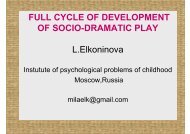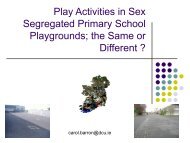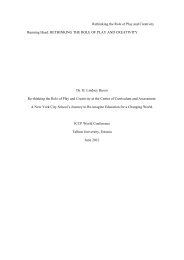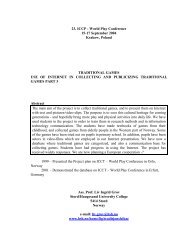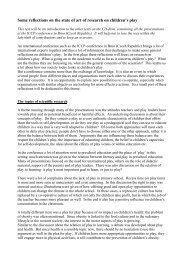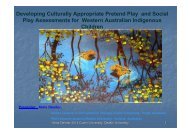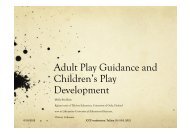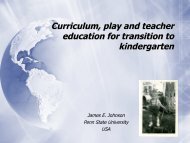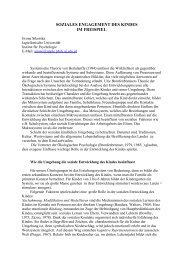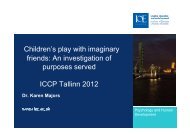Background - International Council for Children's Play
Background - International Council for Children's Play
Background - International Council for Children's Play
Create successful ePaper yourself
Turn your PDF publications into a flip-book with our unique Google optimized e-Paper software.
• Maximum flexibility<br />
• Both gross motor and fine motor play<br />
• Constructive and role play is central<br />
• Maximum children - minimum area<br />
• Minimum of accidents, calculable risks<br />
Conclusion<br />
It is sad that 99% of the schools in Norway have used millions of crones to purchase readymade<br />
climbing frames and other play apparatus that do not stimulate varied, flexible and<br />
developing play, instead of the much cheaper hut building.<br />
Why have 99% of the schools in Norway neglected to plan <strong>for</strong> a hut town, where the children<br />
are constructing and deconstructing their own out door play space?<br />
I think some reasons are the following adult attitudes:<br />
• Have never seen such a hut town in function<br />
• Huts should be in the <strong>for</strong>est<br />
• What is wrong with empty asphalt and football?<br />
• Hut building is dangerous<br />
• To little space in the school yard<br />
• No money (have used them to costly commercial apparatus!)<br />
• Ugly, scrappy, chaotic, the teacher is loosing control<br />
• Will soon be damaged of vandals<br />
• To much work <strong>for</strong> the teachers<br />
• Have not heard about it in my teacher education<br />
But I believe that the most important reason is lack of knowledge about play research and<br />
the best conditions <strong>for</strong> outdoor play, and lack of technical knowledge about materials and<br />
constructions. A building playground project with continuous changes possible, such as<br />
the projects reported herein, will stimulate the neglected constructive play and dramatic<br />
role-play outdoors. At the same time our approach is a much cheaper solution to the<br />
problem of providing outdoor play space and objects; and such an approach teach also<br />
the children that recycling the materials is important <strong>for</strong> global conservation of natural<br />
resources. This is an important lesson <strong>for</strong> the children of our wealthy western society.<br />
Literature<br />
Albertsen S (1991) Bygge på skoleplassen? FOU oppgåve i 6-10 årspedagogikk. Stord<br />
lærarhøgskule<br />
Andersen/Svane (1982) Gjør noe med skolegården. Forbruker- og<br />
Administrasjonsdepartementet<br />
Borgen C (1990) Den fantastiske leken. Skolefritidsordninger. Kompendium nr. IV<br />
Fellessekretariatet <strong>for</strong> skolefritidsordninger. KUF<br />
(1990) Tilrettelegging av lek og leke<strong>for</strong>mens utviklende betydning <strong>for</strong> barns<br />
personlighetsutvikling. Kompendium nr IV.<br />
Fellessekretariatet <strong>for</strong> skolefritidsordning.<br />
Brostrøm S (1995) 6-9 årspædagogik. Leg, leg, rammeleg. (<strong>Play</strong>, play, frame play)<br />
Systime A/S Aarhus<br />
Flemmen A (1993) Ekte leik på den politiske dagsorden i Kroppsøving årg. 43 nr<br />
7/8<br />
(1996) Høringsuttalelse: Læreplan <strong>for</strong> faget kroppsøving i Kroppsøving årg 46,<br />
nr 1<br />
Haug P (1991) 6-åringane-barnehage eller skule? Det norske samlaget. Oslo<br />
(1996) Barnehage på skule. Norsk senter <strong>for</strong> barne<strong>for</strong>skning. Trondheim<br />
8




